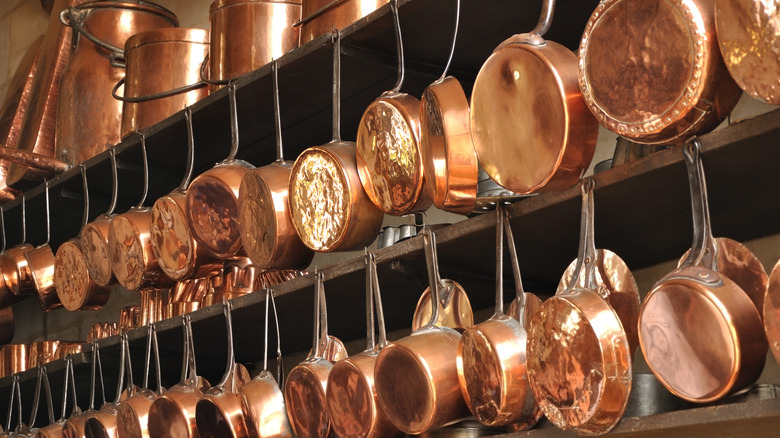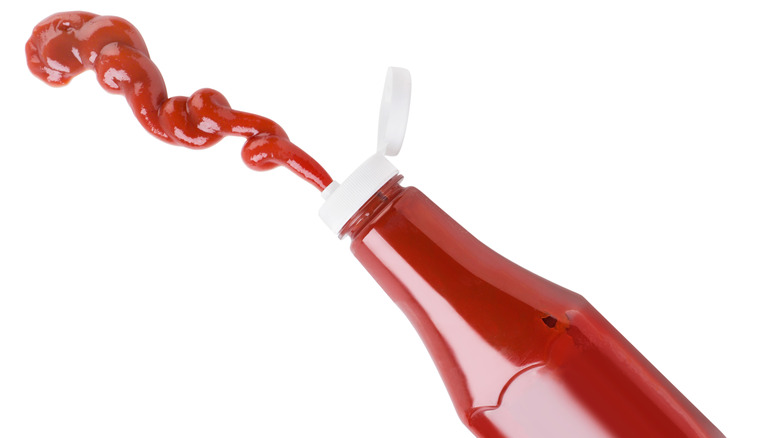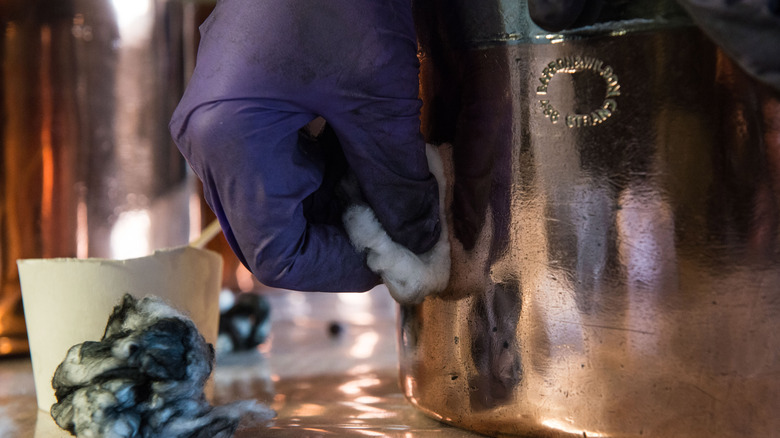You Should Be Cleaning Copper Pans With Ketchup
Copper cookware is the aspiration of countless home cooks and professional chefs. The pricey pots and pans are not only the absolute best in conducting even heat for better cooking, but they are stunningly beautiful, often put on display in the kitchen rather than tucked away in a cabinet. Many people spend a lifetime acquiring a full set, so to say it's important to properly care for the pieces is obvious. Herein lies the tradeoff of owning such delicate cookware; a soak and a scrub with dish soap like you would do with stainless steel or nonstick pieces isn't going to cut it, especially if your copper has accumulated lots of tarnish.
If you've spent a fortune on your copper, you probably assume that the cleaning products for it are also costly, but think again. The secret to keeping your saucepan sparking lies in ketchup. Why is this? Ketchup contains acid and salt, which will remove the tarnish from copper. All you need to do is apply the condiment to the tarnished areas, let it sit for a bit, and wipe it off with a soft cloth. Mustard and relish need not apply.
Salt + acid = a great copper cleanser
There are two types of copper cookware: lacquered and not lacquered. The lacquered type is glazed to protect the copper from discoloration as time goes by and makes the cookware noticeably shiny. The box or tag of any given copper piece should indicate whether it has a lacquered finish. This type of cookware is very easy to care for and should come clean with some soap and water. Copper that's not lacquered is the kind that will tarnish over time. This is the type you'll most likely squeeze your ketchup bottle on. If you let the tarnish sit without cleaning it, the copper will take on a natural patina finish — that blue-green color you see on antique copper pieces.
If you don't have ketchup, you can make a paste out of tomato paste and salt and apply it to the copper the same way. Once you wipe the tomato mixture or ketchup off and give the pan a rinse, be sure to dry it immediately, as water will speed up the rate of tarnish as well. If you have a heavy build-up of tarnish, you may have to go to a stronger acid, like lemon juice. Just slice a lemon in half, dip the cut end into kosher salt and scrub the tarnished areas of the copper. Once you see the copper color returning, wash the pan with soap and water and dry.
What not to do with copper
If you try these methods and the tarnish just won't go away, you may have a severe level of build-up that needs some extra muscle. In this case, you may have to employ some heat or a cleanser specifically for copper. In all of these situations, you should remember that there are some things you should never subject your copper cookware to. You don't want to use harsh scrubbing material, like steel wool, on copper. Stick to a soft cloth or sponge to gently clean the delicate metal. Never put copper cookware in the dishwasher, clean it with bleach, or leave it wet.
Most copper cookware is lined with tin, which is why you often find that the interior of a copper cook piece looks silver in color. Because of this, the interior shouldn't tarnish and can typically be cleaned with dish soap and water; it's the exterior that you'll be treating against tarnishing. If the tin ever wears down on a particular pot or pan so that you can see the copper color coming through, you'll want to avoid cooking in it. Copper cookware is certainly an investment but with the proper care, it should last a lifetime and stay beautiful with a bit of help from a common condiment.



